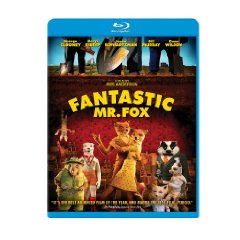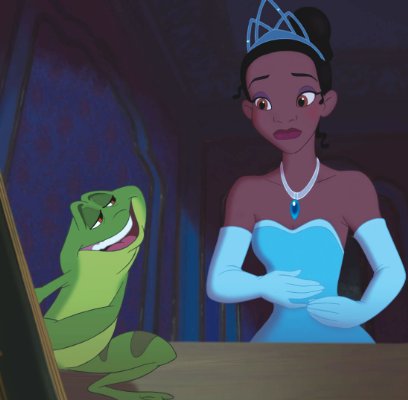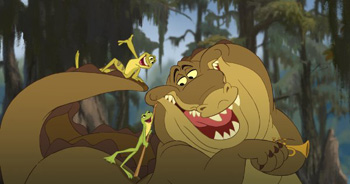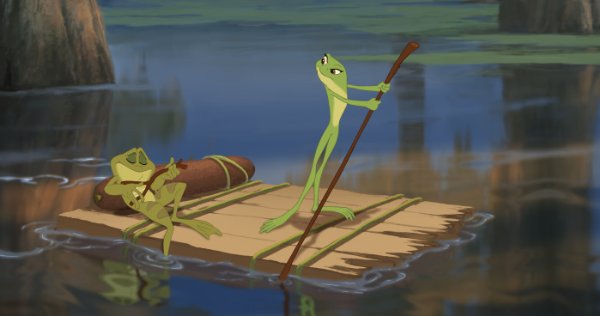
COMMENTARY
Foxes and Frogs
I went to see Wes Anderson's Fantastic Mr. Fox with high expectations. That stop-motion film was praised by people whose judgment I respect, including some big-gun reviewers, but I came away disappointed. I haven't read Roald Dahl's book, but in the film there is, for me, a fatal disconnect between what is at bottom a real cartoon story, easily imaginable in CGI or even hand-drawn animation, and the film's characters, who appear to have been imported from a taxidermist's inventory and then animated with a corresponding stiffness. (I'm sure I've seen real stuffed foxes dressed similarly to Mr. Fox—specifically, like a fox hunter—even if not recently.)
 That disconnect is, I suspect, exactly what Anderson wanted. I can recall for sure seeing only one of his previous features, Rushmore (live action, like everything else he has done), but I remember feeling a comparable irritation at what seemed to me his willful confounding of an audience's legitimate expectations. When confronted by a film that arouses such feelings of unease, it may be tempting to, in effect, take the filmmaker's side—you mean, you don't get it?—by mislabeling arrogance as creativity. But arrogance is, I think, the correct diagnosis.
That disconnect is, I suspect, exactly what Anderson wanted. I can recall for sure seeing only one of his previous features, Rushmore (live action, like everything else he has done), but I remember feeling a comparable irritation at what seemed to me his willful confounding of an audience's legitimate expectations. When confronted by a film that arouses such feelings of unease, it may be tempting to, in effect, take the filmmaker's side—you mean, you don't get it?—by mislabeling arrogance as creativity. But arrogance is, I think, the correct diagnosis.
Mr. Fox's voice work is outstanding, though, easily the best thing about the movie. There's nothing wrong with using stars' voices if the stars can act as well as George Clooney and Meryl Streep and their colleagues. Give Anderson points for understanding that.
I expected less of The Princess and the Frog, the new Disney hand-drawn feature, and in many ways I got what I expected. There's a lot wrong with the movie, but I think its root problem is the same as that of most other Disney animated features made since Jeffrey Katzenberg's departure from the studio in 1994: it feels like a film assembled by a committee, rather than one dominated by a single creative intelligence. I don't admire Katzenberg or his formulaic filmmaking, and I actively detest many of his DreamWorks features, but I think it's clear in retrospect that the Disney hand-drawn features made under his supervision cohered in a way that the later Disney features have not.
Most Disney features of the last two decades have had two co-directors, an arrangement that makes sense only when another person is clearly in charge, as Katzenberg was in the '90s when Disney made such hits as The Little Mermaid, The Lion King, Aladdin, and Beauty and the Beast. Having one director, or one boss of any kind, isn't a guarantee of good results, but the more diffuse the control, the greater the danger of mediocre results, or worse.
The difference that Katzenberg's departure made was evident as early as Hercules (1997), which was co-directed by John Musker and Ron Clements, the co-directors of The Princess and the Frog. Hercules is in its first half totally a lampoon, but then in its second half it suddenly remembers that it is, after all, a Disney film, and it asks us to take seriously characters that have until then been presented as cardboard cutouts. It's hard for me to believe that so clearly unworkable a narrative scheme was any one person's bad idea.
 That aura of compromise, of splitting the difference and thus winding up with something that doesn't quite work on anyone's terms, hangs heavy over The Princess and the Frog, especially where race is concerned. Princess is, of course, not only the first Disney hand-drawn feature in five years but the first Disney animated feature with a black leading character—Tiana, the princess of the title—and I don't want to shrug off the importance of that. When I saw the film at a weekday matinee, several black mothers were in the audience, each accompanied by two or more small children; it was wonderful that those children could see on the screen strong, admirable cartoon characters whose dark skin looked like theirs.
That aura of compromise, of splitting the difference and thus winding up with something that doesn't quite work on anyone's terms, hangs heavy over The Princess and the Frog, especially where race is concerned. Princess is, of course, not only the first Disney hand-drawn feature in five years but the first Disney animated feature with a black leading character—Tiana, the princess of the title—and I don't want to shrug off the importance of that. When I saw the film at a weekday matinee, several black mothers were in the audience, each accompanied by two or more small children; it was wonderful that those children could see on the screen strong, admirable cartoon characters whose dark skin looked like theirs.
The problem is, Princess offers us a 1920s New Orleans in which racial awareness is all but nonexistent. To be sure, New Orleans has always been more cosmopolitan than most Southern cities, but still, it has always been a Southern city, in a slave state that was part of the Confederacy. I know of no reason to believe that it was ever the enlightened urban environment that the film presents; surely not in the 1920s, which were probably the high-water mark for vicious racial discrimination in the United States in the decades after the Civil War.
Jeff Kurtti's "making of" book, The Art of The Princess and the Frog, skitters past questions of race, and the film does the same, presenting a fantasy New Orleans in which whites and blacks dine congenially at adjoining tables in restaurants of various kinds. There's a hint of residential segregation, but I'm not sure that is owing to anything more than a desire to put both the Garden District and the Ninth Ward on film. And then there's Naveen, the prince who is turned into a frog and who himself turns Tiana into a frog—accidentally—by kissing her. In his human form, he is dark-skinned but with vaguely European features, and he attracts adoring white girls. What is he, exactly? Why is he not an unequivocally black African prince? Would that make the film's fudging of race too obvious?
(Kurtti's book makes much of how closely Princess' designers studied New Orleans, and certainly what is on the screen looks generally right, but after many visits to that city I see in it semi-tropical rot—of various kinds—that is totally absent from the film's lovingly painted backgrounds. Its spiffy New Orleans, depicted by Californians, has more in common with New Orleans Square at Disneyland than it does with the real city.)
Princess' story is hopelessly complicated in ways I can attribute only to an effort to patch inconsistencies and tie up loose ends by adding still more complications—exactly what you'd expect from a committee effort. What is it that the villain, the voodoo man Dr. Facilier, really wants? The answer to that question keeps expanding, until Facilier seems as megalomaniacal as a Marvel Comics super-villain. There's a razzle-dazzle number that's deftly handled by the animator Bruce Smith but succeeds mainly in presenting Facilier not as a supernatural menace but as a song-and-dance man.
There are comparably intricate and fast-paced sequences elsewhere in the film, both comic and musical. I have to believe that they appealed to Princess's filmmakers because as such a sequence becomes faster and more complex it poses challenges that are mainly technical: the critical question is how the action is to be made to read clearly, never mind whether it illuminates a character, advances the story, or adds much of anything to the film.
 Absent in Princess—especially in its handling of race, but also in the film generally—is the driving impulse toward the simple and straightforward that has distinguished all the best Disney features. Consider Naveen again: how many problems might have been solved, how much more direct and appealing the story might have been, if the Disney people had followed the lead of the Grimms' version of the fairy tale, so that we simply didn't see Naveen as his human self until the end of the film.
Absent in Princess—especially in its handling of race, but also in the film generally—is the driving impulse toward the simple and straightforward that has distinguished all the best Disney features. Consider Naveen again: how many problems might have been solved, how much more direct and appealing the story might have been, if the Disney people had followed the lead of the Grimms' version of the fairy tale, so that we simply didn't see Naveen as his human self until the end of the film.
The human Naveen and the frog Naveen seem like very different characters, anyway. The human prince is supposedly charming and feckless but is actually hopelessly bland, the frog prince is a comic figure, smug and selfish and generally ridiculous. (By contrast, the human Tiana and the frog Tiana are, thanks to Aniki Noni Rose's assertive voice acting and Mark Henn's subtly complementary animation, recognizably the same character.) Princess has what is in fact a marvelous ending, as Tiana and Naveen accept their fate and prepare to remain frogs for the rest of their lives, only to be restored to humanity in a miraculous but wholly plausible manner. As delightful and even touching as this ending is, how much more thrilling it might have been if it were our first sight of Naveen, and if he were a handsome young black man who called up memories of Tiana's strong and loving father, who is seen briefly at the very beginning of the film.
Here we come to what I find likable and even encouraging about Princess, for all its clumsiness. Once Tiana and Naveen, as frogs, have fled to the bayou, and the film begins devoting itself to their struggle to escape predators and find some way to return to human form, it springs to life. There's a moment that for me sums up what's right about this part of the movie, when the frog Tiana, annoyed by Naveen's inability to dice some mushrooms, takes over and dices them quickly and expertly, as befitting a young woman whose ambition is to own her own restaurant. Perhaps in part because I am married to an excellent cook who is not always patient with her sous-chef, this episode felt real to me, and the same is true of much of what else happens in the bayou: the two frogs grow to depend on each other, and care about each other, in a way that feels remarkably natural, in contrast to the forced affection that is the norm in so many other animated films.
The animation of the frog Naveen—Randy Haycock was the supervising animator—is very much in the CalArts/Chuck Jones vein, as opposed to the stock-Disney handling of the human Naveen, but that turns out to be a plus, because the frog Naveen is expressive in such an economical, no-time-wasted manner, like a good Warner Bros. character. The changes in him, from smirking lout to loving swain, are, as a result, much more convincing than the Disney norm. (Josie Trinidad's storyboards also deserve considerable credit here, to judge from the drawings reproduced in Kurtti's book.) Most of the film's animation is blessedly free of the deadly Bluth-style self-consciousness that infected the previous Musker-Clements feature, Treasure Planet.
Some of the film's Warner-flavored slapstick goes over the top—there's no reason to see the frog Naveen smashed by the heavy book Tiana wields before she becomes a frog herself, when seeing him dodge the blow could have made the same point, probably in a funnier fashion. But I was pleasantly surprised to find myself laughing more than once during the bayou sequence. Even the trumpet-playing alligator, Louis—a terrible idea, on the face of it—turns out to be a winning character, because nothing gets in the way of accepting him as an obsessive musician who just happens to be a very large reptile. I have never admired Eric Goldberg's animation as much as I've wanted to, and his animation of Louis is no exception, because it is appropriately broad but lacks the necessary precision. Ward Kimball's expert blending of the broad and the precise was wanted here, and Goldberg's animation is not quite that good. But it serves the purpose.
There is the kernel of a very good, very funny animated feature inside The Princess and the Frog. It's tempting to hope that someone in authority at Disney will recognize that and find some way to put the many talented people who made Princess to work on material that has not been fatally muddled. Unfortunately, I can't believe that will happen—everything about the Disney studio's recent history argues against it. Certainly there's no reason to think that John Lasseter will come to the rescue. It's pleasing, though, to think that there's even the slimmest possibility of something really good coming from Disney. I don't feel that way about Jeffrey Katzenberg.

[Posted December 27, 2009]